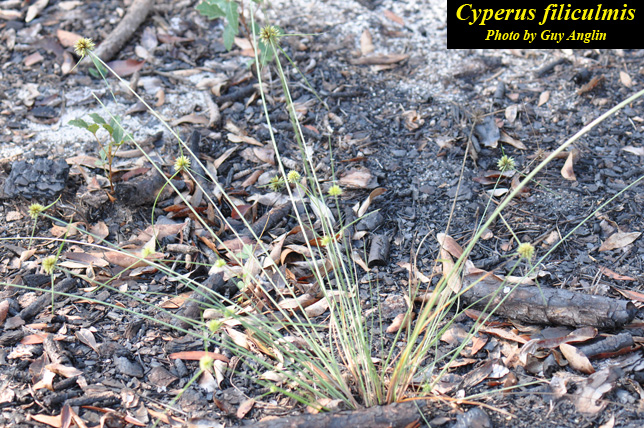Difference between revisions of "Cyperus filiculmis"
(→Distribution) |
|||
| Line 29: | Line 29: | ||
==Distribution== | ==Distribution== | ||
| − | ''C. filiculmus'' is native from southeast Maryland along the east coast south to southern peninsular Florida.<ref name= "Weakley">Weakley, A. S. (2015). Flora of the Southern and Mid-Atlantic States. Chapel Hill, NC, University of North Carolina Herbarium.</ref> | + | ''C. filiculmus'' is native from southeast Maryland along the east coast south to southern peninsular Florida, and west to eastern Texas.<ref name= "Weakley">Weakley, A. S. (2015). Flora of the Southern and Mid-Atlantic States. Chapel Hill, NC, University of North Carolina Herbarium.</ref> |
==Ecology== | ==Ecology== | ||
Revision as of 08:55, 25 April 2019
| Cyperus filiculmis | |
|---|---|

| |
| Photo by Guy Anglin, Atlas of Florida Vascular Plants | |
| Scientific classification | |
| Kingdom: | Plantae |
| Division: | Magnoliophyta - Flowering plants |
| Class: | Liliopsida – Monocotyledons |
| Order: | Poales |
| Family: | Cyperaceae |
| Genus: | Cyperus |
| Species: | C. filiculmis |
| Binomial name | |
| Cyperus filiculmis Vahl | |

| |
| Natural range of Cyperus filiculmis from USDA NRCS Plants Database. | |
Common name: Southeastern Flatsedge
Contents
Taxonomic notes
Synonyms: Cyperus lupulinus ssp. lupulinus; (Cyperus martindalei Brittton The Flora of North America).
Varieties: none
Description
A description of Cyperus filiculmis is provided in The Flora of North America.
Distribution
C. filiculmus is native from southeast Maryland along the east coast south to southern peninsular Florida, and west to eastern Texas.[1]
Ecology
Habitat
Cyperus filiculmis is found mainly in sandy soils, both wet and dry, including drying loamy sand, coarse sand, and moist sandy-peaty soil. It prefers sunny, open sites, and occurs in longleaf pine-wiregrass flatwoods and longleaf pine-turkey oak sand ridges. C. filiculumis is seen in disturbed habitats such as power line corridors, clear-cuts, and bulldozed or logged sites.[2]
Associated species includes Pinus palustris, Quercus laevis, and Aristidia stricta.[2]
Phenology
C. filiculmis has been observed both flowering and fruiting in May through November with peak inflorescence in June and August.[3][2] It is also known to flower between July and September.[1]
Seed dispersal
This species is thought to be dispersed by gravity.[4]
Fire ecology
This species is fire tolerant, and has been observed in recently burned pine flatwoods.[2]
Conservation and management
Cultivation and restoration
Photo Gallery
References and notes
- ↑ 1.0 1.1 Weakley, A. S. (2015). Flora of the Southern and Mid-Atlantic States. Chapel Hill, NC, University of North Carolina Herbarium.
- ↑ 2.0 2.1 2.2 2.3 Florida State University Robert K. Godfrey Herbarium database. URL: http://herbarium.bio.fsu.edu. Last accessed: June 2014. Collectors: Loran C. Anderson, R. L. Lazor, R. K. Godfrey, R. F. Thorne, R. A. Davidson, S. W. Leonard, Gary R. Knight, Richard Carter, C. Jackson, J. B. McFarlin, R. Kral, Mabel Kral, J. B. McFarlin, Gwynn W. Ramsey, R. S. Mitchell, R. A. Norris, Steve L. Orzell, Richard Gaskalla, J. M. Kane, Cecil R. Slaughter, and Nancy Coile. States and Counties: Florida: Bay, Brevard, Calhoun, Citrus, Clay, Duval, Franklin, Gadsden, Gilchrist, Highlands, Leon, Liberty, Okaloosa, Polk, Sarasota, St. Johns, Suwannee, Taylor, and Wakulla. Georgia: Baker, Coffee, Liberty, and Thomas
- ↑ Nelson, G. PanFlora: Plant data for the eastern United States with emphasis on the Southeastern Coastal Plains, Florida, and the Florida Panhandle. www.gilnelson.com/PanFlora/ Accessed: 8 DEC 2016
- ↑ Kirkman, L. Katherine. Unpublished database of seed dispersal mode of plants found in Coastal Plain longleaf pine-grasslands of the Jones Ecological Research Center, Georgia.